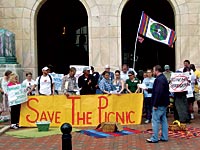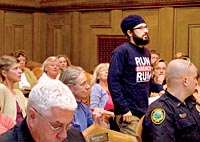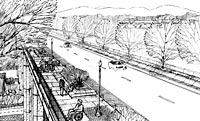If someone new to Asheville wanted a crash course on the city’s top concerns and hot buttons, City Council’s April 24 meeting would have served as a suitable primer. In the six-and-a-half-hour session, Council members touched on a greatest-hits package of Asheville’s perennially controversial topics, including homelessness, development, traffic and the environment.

Takin’ it to the streets
The meeting was prefaced by an ad hoc demonstration on the steps of City Hall by a group calling itself Save the Picnic. The roughly 45 people who turned out to show support for the Saturday breakfasts in Pritchard Park were led by the Rev. Amy Cantrell, a staunch local advocate for the homeless.
Mayor Terry Bellamy spoke briefly at the demonstration. Reminding the group of Council’s support for such initiatives as the public restrooms now in the works and the “10-Year Plan to End Homelessness,” she argued that the present City Council has been particularly sensitive to the needs of the homeless population. “This is an effort not just to talk of things, but to walk it out,” Bellamy declared, to applause from the demonstrators.
Since the city’s most visible park was renovated a number of years ago, some downtown business owners have complained that homeless people’s continual presence there hinders the tourist trade. So far, the city has taken a dim view of the breakfasts handed out at the park by nonprofit groups, and occasional outbursts of crime and violence have further loaded the issue. Now, Council was establishing a committee to consider changes to the park’s design and the city’s policies there.
Inside the Council chamber, Cantrell and others urged city leaders to add representatives of the homeless community to a list of committee members proposed by the Parks and Recreation Advisory Board and the Downtown Commission.
“As you make this committee, we hope that voices from the streets will be heard,” said Cantrell. “We don’t need more regulations—we need more relationships. …That park is the heart of us and the heart of the city.”
Several other speakers also spoke on behalf of the park’s controversial population, emphasizing the sense of community fostered by the meals. “Getting the food out of Pritchard Park gets rid of one of the chief elements we have for building the community,” argued Food Not Bombs volunteer Lindsay Popper.
After reiterating her earlier point about City Council’s efforts on behalf of the homeless, the mayor called on the homeless community and its advocates to assume responsibility for halting the unacceptable behavior at the park, including public urination and defecation.
“When we get those bathrooms open, excuses will be gone,” said Bellamy, adding, “We cannot have separate laws just because someone is homeless.”
Council members Brownie Newman and Bryan Freeborn both concurred with Cantrell’s call to have the homeless represented on the committee.
“They are using [the park], and they are the public,” noted Freeborn. “They should have a voice in the process.”
Asked by Bellamy if she would serve on the committee, Cantrell said she would—provided that an actual homeless person also be allowed to serve. Council unanimously approved the list and the additional appointments.
UDO what you have to

In recent months, a number of developers—noting that they could build sprawling, low-density neighborhoods of single-family homes without Council approval—have used that as a bargaining chip when seeking conditional-use permits for other types of projects. In response, unhappy city residents have called for changing the Unified Development Ordinance to give community members a say about large-scale development in their area. As a result, subdivisions involving 50 or more lots will now come before Council for review.
In one case in Beaverdam, the prospect of a sprawling subdivision was a factor in Council’s reluctant approval of a gated community. And in Kenilworth, another developer has gone ahead with plans for a large subdivision after being denied a conditional-use permit.
With those issues in mind, Council members scrutinized the wording of the proposed changes to the UDO. Freeborn wanted to make sure the new language would effectively close the loophole. “Under this ordinance, would the subdivision that is going up in Kenilworth have come to Council?” he asked Assistant Planning Director Shannon Tuch.
“Yes,” she replied.
Another amendment, requiring a 1,500-foot buffer between four-unit subdivisions, caught the attention of Council member Robin Cape. The move, Tuch explained, is intended to prevent multiple small subdivisions from being bundled to form a de facto larger one. Cape, however, argued that the designation seemed arbitrary and that limiting density could hinder efforts to develop affordable housing.
“It seems like you want to give a framework rather than just a circle,” said Cape, asking for more flexibility in the rule.
Council approved the changes on a 6-1 vote, with Council member Carl Mumpower opposed. Tuch assured Council that she would draw up options for addressing Cape’s concern.
The bulk of public comment was reserved for three other UDO amendments—especially the hotly anticipated steep-slope ordinance. In the end, however, the weight of the issue led Council members to hold off on debating and voting until their next meeting.
“Planning and Zoning spent six months on this issue,” noted Bellamy, who proposed the delay to give Council members time to digest the information gleaned from the meeting.
The staff proposal would regulate 15 percent or greater slopes at 2,200 feet elevation and up; below 2,200 feet, only those with a slope of 25 percent or greater would be affected. The proposed ordinance specifies road widths and sets limits on grading, tree removal and building height for steep-slope development.
Some residents argued that the proposed limits aren’t stringent enough, but a recommendation from the Planning and Zoning Commission called for having the restrictions kick in at 2,500 feet—which would have exempted an additonal 7,000 acres from the new rules.
“We don’t have a lot of developable land,” noted Biltmore Farms Vice President Paul Szurek.
But the vast majority of those who spoke during the public-comment period pleaded with Council to hold the line at 2,200 feet. “Asheville needs a strong ordinance,” declared Jake Quinn, president of the Grove Park/Sunset Mountain Neighborhood Association. “We have recently become alarmed at what we see as unbridled growth.”
“These mountains are half-a-million years old,” stressed north Asheville resident Mike Lewis. “The forests have recovered somewhat in the past 100 years. Please take care of them.”
Others, including mountainside-property owner Robert Coxe, were concerned about the ordinance’s impact on their future. In order to build on his land, he said, it would have to be grandfathered. “You’re going to be pinching people like me,” said Coxe. “I’ve owned that lot for 20 years with the idea that I would be able to build my dream home.”
Still others, both on Council and in the community, fear the steep-slope rules could hurt efforts to develop affordable housing. Newman noted that he’d heard such concerns from Mountain Housing Opportunities, a local nonprofit.
And Cape proclaimed: “I stand for protecting the mountains. But I also stand for building where we can.” She called for levying steep fines on irresponsible developers and limiting the size of retaining walls.
Albemarle Park resident Jane Mathews dismissed that line of thinking. “The argument being used for affordable housing upsets me,” she said. “The developments being built are not affordable.”
Bellamy noted that the city may have to consider compensating landowners who find themselves on the wrong side of the elevation threshold. Meanwhile, Council members will continue to mull over the comments made and solicit more facts from staff in preparation for their deliberation and vote on May 8.
LEED, follow or get out of the way

Concerned about global warming, Council endorsed the recommendations of the Sustainable Energy and Environment Advisory Committee, making a commitment to reducing energy consumption in city-owned buildings and designing future municipal structures to green building standards.
Public Works Director Mark Combs, the staff liaison to the committee, told Council that the city now spends $2.98 million on electricity and $1.1 million on fuel each year. “We spend a significant amount of money on energy just to keep rolling,” he said.
The recommendation calls for cutting the city’s energy use by 2 percent a year until an 80 percent reduction from current levels has been achieved, “a solution commensurate with the scale of the problem,” according to the 2006 “Stern Review on the Economics of Climate Change,” a highly influential British government report.
Mumpower balked at the notion of setting a specific target, questioning the accuracy of the numbers and wondering why city departments weren’t simply directed to cut energy use and costs wherever they could.
City Manager Gary Jackson explained that while staff is sensitive to the need for conservation, it lacks an accurate template on which to base such cuts.
Meanwhile, Newman stressed that the 80 percent mark is what’s needed to reduce the threat of global warming. “I wish the 80 percent goal was arbitrary,” he said. “It is based on what a vast majority of the scientific community agrees we have to do.” And even that, he said, won’t halt the effects of global warming; it will merely avoid the worst-case scenario.
Council approved the cuts in energy consumption on a 6-1 vote, with Mumpower opposed.
But Council’s lone Republican did support the committee’s recommendation that the city seek LEED certification for future municipal buildings after a presentation outlining the long-term financial savings. The U.S. Green Building Council’s Leadership in Energy and Environmental Design rating system designates four levels of green building, in ascending order of cost and energy savings.
Combs’ presentation called for using gold, the second-highest classification, for buildings comprising 5,000 square feet or more, and silver for smaller structures. Both types of design cost slightly more to build than conventional consruction but pay for themselves within four years and save an estimated 37 percent and 30 percent per year, respectively, in energy costs, he said.
“If those numbers are correct, then it wouldn’t make sense to do anything but what is proposed,” said Mumpower. And as the technologies improve and contractors become more familiar with the design concepts, the construction costs could be lower, noted Mathews, an architect who serves on the committee.
The measure passed unanimously, and Mayor Bellamy asked the committee to move on to the next step: formulating an education campaign aimed at the general public.
A better bridge
Plans from the Asheville Design Center for a bridge over the French Broad River won hurrahs from Council members, who asked city engineers to have a gander before an upcoming N.C. Department of Transportation presentation. The DOT has proposed five alternatives for the I-26 connector, but according to the Design Center’s Alan McGuinn, all of them have “fatal flaws.”
Using diagrams of the DOT proposals, McGuinn identified various problems, such as creating barriers between downtown and West Asheville, failing to remove I-240 traffic from Patton Avenue, and reducing developable land.
Modifying one of the DOT’s alternatives, the design group has proposed a double-decker bridge just north of Westgate Shopping Center, with Interstates 26 and 240 on separate levels. The design, McGuinn contends, keeps Patton Avenue as a “main street” connecting West Asheville to downtown and preserves land for future westward expansion of downtown—while saving about $150 million in construction costs.
“I’ve seen this presentation several times, and it just gets better and better,” said Cape. “There’s a lot of land in our community that does not need to be an interchange.”
McGuinn said the design group had met with DOT officials several weeks ago, who asked for more information. “We’re starting to prove that it does work,” he said, cautioning that he’d like to have more engineers review the design.
With the DOT slated to appear before Council on May 8, Council members supported bringing in some city engineers to make sure all the necessary parts are there and that questions the DOT might raise can be answered.
Newman voiced support for the plan as a welcome change in a long-running controversy that has more typically been marked by groans of protest. “It’s been a lot of people debating what they don’t want,” he noted, adding, “This is a specific design that the community can really fight for.”
Mixed messages
At their March 13 meeting, Council members had approved a resolution to the N.C. General Assembly spelling out the terms under which the city would support an increase in the sales tax. The Legislature enacted a half-cent increase in the sales-tax rate after during the state’s 2000 budget crisis. Half of that was removed at the end of last year, and the remaining quarter-cent is set to expire June 30.
The move was an attempt to show Council’s displeasure with the funding method (city leaders had asked for permission to increase the hotel-room-occupancy tax—see “Terms of Enragement,” March 21 Xpress).
In addition, the resolution specified acceptable terms for settling the city’s lawsuit over the Sullivan Acts and long-running water dispute with Buncombe County. It also called for eliminating the sales tax on groceries, allowing the city to allocate 30 to 40 percent of the new revenue for affordable housing and other poverty-related issues, and increasing the hotel-room tax to help fund Civic Center renovation and building a new performing-arts center. Only under those conditions, said Council, could it support the sales-tax increase.
Now, however, Bellamy—who’d recently traveled to Raleigh to meet with members of the local legislative delegation—was back to report what seemed an odd response from state legislators: asking what the city would use the money for.
“The ball is rolling quickly,” she assured her Council colleagues. “The conversations are being held currently.”
To some on Council, however, the question smacked of a political strong-arm tactic to get the city to appear to be on board with a sales-tax option it had already rejected. “If we give them a list, they will hold it up and say, ‘Of course they support this: Look at this list,’” predicted Newman.
But still, ideas on how to spend the additional $6 million in projected annual revenues quickly surfaced, from infrastructure repairs to public transit to affordable housing. “It provides the opportunity to provide a lot of things that need to be provided,” noted Davis.
With the hour growing late, however, the discussion grew increasingly divided. “I think it sends the message that we want this more than the majority of Council [actually does],” said Vice Mayor Holly Jones.
In the end, Council sent a resolution reiterating that the city would use the additional revenue for affordable housing and unspecified capital improvements. The vote was sharply divided, with Freeborn, Bellamy, Davis and Cape in favor and Newman, Jones and Mumpower opposed.
Your move, Raleigh.




Before you comment
The comments section is here to provide a platform for civil dialogue on the issues we face together as a local community. Xpress is committed to offering this platform for all voices, but when the tone of the discussion gets nasty or strays off topic, we believe many people choose not to participate. Xpress editors are determined to moderate comments to ensure a constructive interchange is maintained. All comments judged not to be in keeping with the spirit of civil discourse will be removed and repeat violators will be banned. See here for our terms of service. Thank you for being part of this effort to promote respectful discussion.